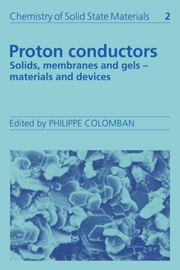Book contents
- Frontmatter
- Contents
- List of contributors
- Preface
- Symbols
- I HYDROGEN BOND AND PROTONIC SPECIES
- II MATERIALS: PREPARATION, STRUCTURES AND PROPERTIES
- III PROTON DYNAMICS AND CHARGE TRANSPORT
- 21 Incoherent neutron scattering studies of proton conductors: from the anhydrous solid state to aqueous solutions
- 22 NMR studies of local motions in fast protonic conductors
- 23 Vibrational spectroscopy of proton conductors
- 24 Raman spectroscopic studies of proton conductors
- 25 Frequency dependent conductivity, microwave dielectric relaxation and proton dynamics
- 26 Measuring the true proton conductivity
- 27 D.c. techniques and a.c./d.c. combination techniques
- 28 NMR in gels and porous media
- IV PROTON DIFFUSION MECHANISMS
- V DEVICES
- Index
22 - NMR studies of local motions in fast protonic conductors
Published online by Cambridge University Press: 04 May 2010
- Frontmatter
- Contents
- List of contributors
- Preface
- Symbols
- I HYDROGEN BOND AND PROTONIC SPECIES
- II MATERIALS: PREPARATION, STRUCTURES AND PROPERTIES
- III PROTON DYNAMICS AND CHARGE TRANSPORT
- 21 Incoherent neutron scattering studies of proton conductors: from the anhydrous solid state to aqueous solutions
- 22 NMR studies of local motions in fast protonic conductors
- 23 Vibrational spectroscopy of proton conductors
- 24 Raman spectroscopic studies of proton conductors
- 25 Frequency dependent conductivity, microwave dielectric relaxation and proton dynamics
- 26 Measuring the true proton conductivity
- 27 D.c. techniques and a.c./d.c. combination techniques
- 28 NMR in gels and porous media
- IV PROTON DIFFUSION MECHANISMS
- V DEVICES
- Index
Summary
Introduction
Nuclear magnetic resonance (NMR) is a well-established local probe for the study of dynamics as well as structure in condensed matter systems. The various NMR spin Hamiltonian parameters (see below) accurately reflect the symmetry and the nature of motions at and around the site of the nucleus being studied. When combined with the variations of thermodynamic parameters such as temperature and pressure, NMR can provide a wealth of microscopic, structural and dynamical information, such as lattice spacings, potential barriers and jump/attempt frequencies of the motion. Therefore it is not surprising that NMR has played a major role in the study of fast ionic conductors (FICs). Advantages of the NMR technique stem from its nuclear specificity, it being a true local probe in the sense that inequivalent sites within a unit cell can be distinguished and its non-destructive nature. Fast protonic conductors (FPCs) are eminently suited for investigations by NMR since protons or hydrogen nuclei are about the best nuclei that can be studied by most of the NMR techniques.
There are a number of review articles summarizing and critically examining the NMR studies of FICs, and many of them contain some discussion of fast protonic conductors. Many features of the NMR studies are similar for protonic and other fast ionic conductors. However, there are also aspects peculiar to FPCs, an important one being the influence of local dynamics.
- Type
- Chapter
- Information
- Proton ConductorsSolids, Membranes and Gels - Materials and Devices, pp. 350 - 366Publisher: Cambridge University PressPrint publication year: 1992
- 1
- Cited by



